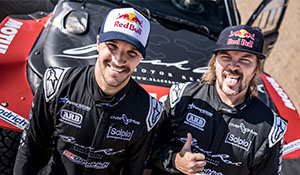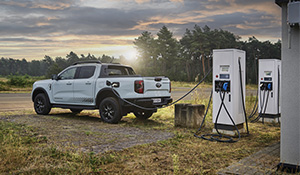How To: Convoy Procedure
Words Dean Mellor

Most four-wheel drivers end up driving in a convoy at some stage, whether they’re partaking in an organised tagalong, a club day or just getting away for the weekend with a few mates. If the convoy is disorganised and uninformed, things can go wrong pretty quickly, leading to hopelessly lost drivers and other problems that can seriously ruin everyone’s day.
By following a few simple convoy rules you’ll ensure that all convoy participants will safely find their way to the intended destination.
Set the rules
An outlined structure will make the day easier on all convoy members, including the Convoy Leader, the Tail End Charlie and everyone in between, so before the drive begins it’s important for the leader to gather everyone together and clearly explain how things are expected to operate throughout the day, and to outline everyone’s individual responsibilities.
The first thing to explain is who the Convoy Leader is, and how that person should be addressed when called on the UHF radio. Even among a group of close friends it’s important that the leader be clearly identifiable – and labelled – as it’s this person’s responsibility to ensure everyone reaches the intended destination. Whether the Convoy Leader is addressed as ‘Bruce’ or ‘Lead Vehicle’ is not important, so long as everyone knows who’s being called on the radio. If there are two Bruces in the group, however, you’ll want to make a clear distinction.
The Convoy Leader will need to appoint a Tail End Charlie. This important role should be assigned to a responsible person with a decent UHF radio in their vehicle. It’s the job of the Tail End Charlie to ensure that no one misses a turn or that if someone has a problem the convoy is stopped until said problem resolved. Before departure, the Convoy Leader should clearly explain the day’s route to the Tail End Charlie, so if the convoy is split there will still be someone who knows where to go.

It’s of paramount importance that everyone understands proper convoy procedure, and the most important rule to keep the convoy together is to ‘mark’ every corner. Marking a corner is simply ensuring the vehicle immediately behind you sees when and where you have made a turn. And so long as everyone marks each turn along the route there’s really no way that the convoy can be split, unless there’s a mechanical breakdown or some other kind of problem, in which case the Tail End Charlie will need to alert the Convoy Leader, or deal with the issue at hand.
Every vehicle in the convoy should be equipped with a good quality UHF radio, and the Convoy Leader needs to ensure everyone knows what channel the convoy will be operating on. There should also be a radio check before departure to ensure everyone is able to communicate clearly with each other; any comms issues need to be resolved prior to departure.
The Convoy Leader should also point out that general chit-chat on the convoy channel should be kept to a minimum. It’s no good if someone has a problem of some descript and they can’t inform the convoy because another person is telling a joke on air. This is the reason some people run two UHF radios in their vehicles – one for convoy comms and one for general comms.
The final thing to explain prior to departure is a general overview of the day’s route plan, including what road and driving conditions might be expected along the route, pointing out any specific hazards and advising of the regularity/location of rest stops, and what facilities (if any) will be available.

> Keeping a distance
Once on the road it’s important that all convoy members keep a safe vehicle distance. Everyone is different, so in most convoys there will be some drivers who seem to stick too close to the vehicle in front and others who seem to drop back too far. If you’re concerned by the proximity of another vehicle in the convoy, try to advise them politely to leave a more suitable gap.
On gravel roads and dirt tracks, the dust generated by each vehicle should open up the gap between vehicles, but this is not always the case, as some drivers will still want to stick as closely as they can to the vehicle ahead of them. In dusty conditions this can be downright dangerous, so tailgating needs to be called out and stopped. After all, the fact all vehicles are equipped with UHF radios negates the need to maintain visual contact with the vehicle in front.

The convoy will naturally spread further apart towards tail end due to the increased amount of dust generated by the vehicles up the pointy end, and this can result in UHF radio range being exceeded, particularly in hilly country where UHF radio range is reduced. When this is the case it will often be necessary for UHF messages to be relayed between the front and rear of the convoy, in which case transmissions between the Convoy Leader and the Tail End Charlie should take priority over all others.
As the convoy proceeds along the route there might be road/track hazards from time to time, in which case the Convoy Leader should alert the rest of the convoy via UHF. This information could relate to oncoming traffic, stock or wildlife on the road or track damage, and, if necessary, should be relayed down the convoy all the way to the Tail End Charlie.

Take a break
As mentioned, prior to departure the Convoy Leader should have advised the convoy of the regularity/location of rest stops along the route. As well as giving everyone a break, rest stops are a great way to bring the convoy back together if it’s been spread apart due to driving or road/track conditions.
If the Convoy Leader has been unable to communicate with the Tail End Charlie, adding in additional stops to regroup the convoy is a good idea. It’s important for the Convoy Leader to find a safe place to pull over and that there will be plenty of space available for all vehicles in the convoy. When stopping, it’s also important to remember that those at end of convoy will need time for a break, so the Convoy Leader shouldn’t just head off as soon as the last vehicle shows up. In fact, this is a good time for the Convoy Leader and Tail End Charlie to get together and have a chat about how the convoy is proceeding, and if there are any problems that need addressing or anything that needs to be pointed out to other convoy members.
Regular stops also provide opportunities to discuss matters such as convoy speed, vehicle gaps or to answer any questions or raise any concerns regarding convoy procedure or radio etiquette.










